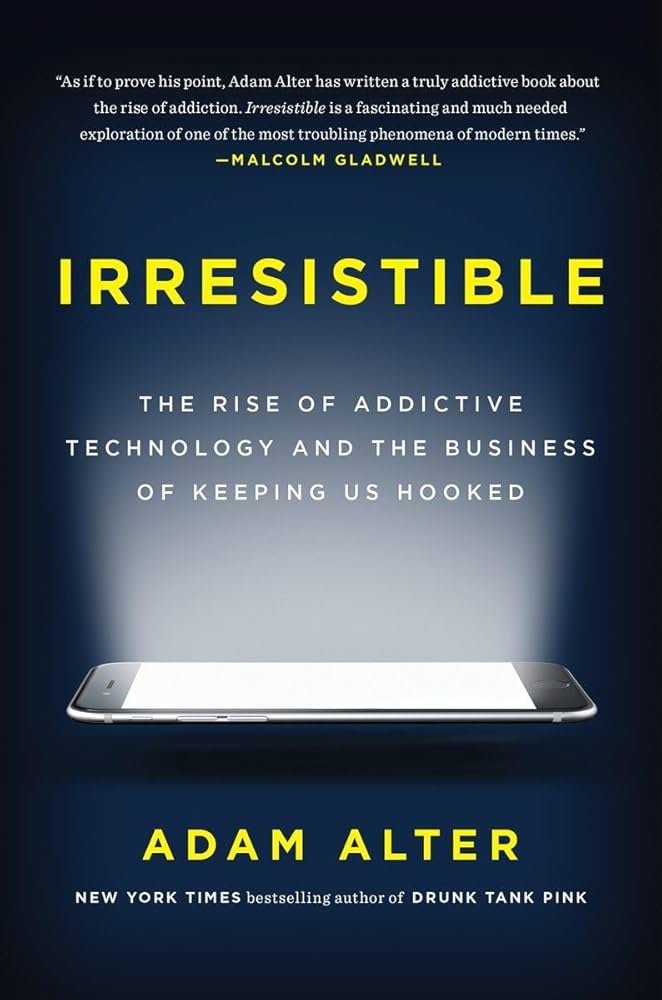Irresistible: The Rise of Addictive Technology and the Business of Keeping Us Hooked
Le prix initial était : $13.99.$4.99Le prix actuel est : $4.99.
by Adam Alter (Author)
Description
Understanding Behavioral Addiction
Behavioral addiction is a concept that has gained significant traction in recent years, as highlighted by Adam Alter in his exploration of modern societal trends. Unlike substance addiction, which involves the physical dependence on drugs or alcohol, behavioral addiction refers to compulsive behaviors that provide pleasure or a sense of reward. This form of addiction underscores the psychological and emotional triggers that compel individuals to engage repeatedly in certain activities, despite potential negative consequences.
One of the defining characteristics of behavioral addiction is the loss of control over the behavior. Individuals often find themselves engaging in activities such as social media use, video gaming, or shopping to the detriment of other areas in their lives, including relationships, work, and personal well-being. The incessant checking of notifications or the urge to achieve the next level in a game can be likened to the compulsion seen in substance addicts. Each time a person receives a « like » on social media or successfully completes a task in a video game, their brain releases dopamine, reinforcing the urge to continue the behavior.
Common examples of behaviors that may lead to addiction include excessive internet surfing, compulsive shopping, and continuous engagement with mobile applications. These behaviors often trap individuals in cycles of temporary satisfaction followed by feelings of emptiness or guilt. The rise of online shopping platforms has further fueled this phenomenon, as instant gratification is readily available, often leading to overspending and subsequent regret.
Understanding the dynamics of behavioral addiction is crucial, as it underscores the broader implications for mental health. Recognizing and addressing these compulsive behaviors can foster healthier habits and ultimately mitigate the adverse effects on individuals and society. As we navigate an increasingly digital world, it is essential to remain vigilant about the addictive potential of our daily activities.
The Mechanisms Behind Addiction
Addiction is a complex phenomenon driven by various psychological and neurological mechanisms. Central to this process is dopamine, a neurotransmitter that plays a crucial role in the brain’s reward system. When individuals engage in pleasurable activities, such as eating or using technology, dopamine is released, reinforcing these behaviors and making them more likely to be repeated. This biological reward system is not inherently problematic; however, when external stimuli exploit these mechanisms for profit, the risk of addiction escalates.
Design choices in technology and consumer products have increasingly become tailored to engage and hold attention for extended periods. Features such as infinite scrolling, notifications, and rewards are deliberately integrated to trigger dopamine release. Thus, users may find themselves irresistibly drawn to platforms or products, often leading to compulsive behaviors. Adam Alter posits that these designs create environments that encourage prolonged engagement, making it difficult for individuals to moderate their usage.
Furthermore, addiction is not solely a result of isolated experiences but is also influenced by social and environmental contexts. Various factors, including the availability of certain stimuli and the presence of social reinforcement, can further entrench addictive behaviors. For instance, when a person observes peers frequently interacting with an app or gaming console, they are more likely to partake in similar activities, fueled by a desire for social validation, thus reinforcing the cycle of engagement and potential addiction.
By understanding these mechanisms, we can better grasp how addiction manifests in modern life. The intersection of psychological vulnerabilities and technological design is significant, prompting discussions on ethical responsibilities for developers and awareness for consumers. Ultimately, insights into these processes help illuminate the complex landscape of addiction in our contemporary technological society.
The Social and Cultural Impact of Addictive Behaviors
Addictive behaviors, particularly those associated with digital technology, have become pervasive in contemporary society. Adam Alter highlights that this rise in addiction influences social interactions, relationships, and mental health, creating a profound cultural shift. As technology pervades daily life, users often find themselves entrapped in cycles of dependency that alter their engagement with family, friends, and the world at large. With smartphones and social media dominating attention, individuals frequently prioritize online interactions over face-to-face relationships, leading to superficial connections and a decline in meaningful socialization.
The impact of addiction transcends individual experiences, manifesting in broader societal implications. Children and adolescents, in particular, are vulnerable to the effects of technology addiction, experiencing changes in social norms and expectations. The 24/7 accessibility to digital content has normalized behaviors such as incessant scrolling through social media feeds or compulsively responding to notifications. This hyperconnectivity fosters an environment where being ‘always on’ is not only expected but celebrated, simultaneously heightening anxiety and diminishing genuine well-being.
Moreover, the cultural acceptance of these addictive behaviors has profound implications for collective mental health. Many individuals grapple with feelings of loneliness and inadequacy exacerbated by the constant comparison prevailing on social media platforms. As society grapples with these challenges, mental health issues tied to technology addiction, such as anxiety and depression, are becoming increasingly recognized. At the core of these issues lies the question of balance—how do individuals navigate technology’s role in their lives without succumbing to dependency? Ultimately, the normalization of addictive behaviors in the context of our digital reality compels society to rethink its values and redefine what constitutes healthy social engagement.
Strategies to Combat Behavioral Addiction
In the contemporary landscape where technology and various stimuli can lead to behavioral addiction, adopting effective strategies becomes vital for individuals seeking to regain control. Adam Alter highlights several practical approaches that can empower individuals to recognize and combat these patterns effectively.
One of the primary strategies is the practice of self-regulation. This involves developing the ability to monitor one’s impulses and reactions in real-time. Self-regulation can be enhanced through techniques such as journaling, which allows individuals to track their daily habits and emotions. By acknowledging triggers and documenting responses, individuals cultivate a deeper self-awareness that is crucial in addressing addictive behaviors. Moreover, setting specific limits on engagement with technology—such as designated screen time—can greatly reduce the constant temptation of addictive stimuli.
Establishing clear boundaries is equally important. This includes carving out tech-free zones or times, such as during family dinners or an hour before bed. By prioritizing personal interactions and fostering connections in the physical realm, individuals can mitigate the pull of addictive technologies and practices. Additionally, involving friends and family in these efforts can provide a support system that encourages positive change.
Mindfulness and meditation are also critical tools to regain control. Practicing mindfulness helps individuals become more aware of their thoughts and feelings, which can diminish the power of cravings associated with addictive behaviors. Techniques such as deep-breathing exercises or guided meditations can equip individuals with the skills needed to face urges without succumbing to them.
Incorporating healthier habits, such as physical exercise, engaging in hobbies, or even volunteering, can shift focus away from addictive behaviors. The more fulfilling and rewarding activities that individuals partake in, the less they may feel the need to rely on addictive stimuli for fulfillment.
Ultimately, fostering a culture of self-awareness, setting stringent boundaries, and promoting healthier alternatives can significantly combat behavioral addiction and lead to a more balanced and satisfying life.
Looking Ahead: The Future of Addictive Design
The evolution of addictive design in technology and media presents a complex landscape that requires thoughtful consideration from all stakeholders. As we move forward, there are several key areas where developments are expected to unfold, particularly concerning regulation, ethical design practices, and innovations aimed at mitigating the addictive aspects of certain products.
Regulatory efforts may become increasingly prominent as governments seek to address the implications of addictive technology. Policymakers are likely to advocate for guidelines that encourage transparency in design features that exploit user psychology. These regulatory frameworks could compel companies to disclose information regarding the addictive qualities of their products and to implement mechanisms that promote healthier usage patterns, reinforcing accountability in the tech industry.
On the ethical design front, there is a growing recognition among developers and designers regarding their responsibilities. Many companies are beginning to shift their focus toward creating products that prioritize well-being over engagement metrics. This trend may result in the development of features that allow users to monitor and manage their digital consumption, empowering individuals with tools that promote a balanced relationship with technology.
Moreover, innovations aimed at reducing addiction potential are anticipated to gain traction. This could include the creation of applications designed to help users reconcile their online presence with real-life interactions, promoting mindfulness during usage. Additionally, artificial intelligence may play a role in customizing experiences to better align with individual preferences and limit over-engagement.
Ultimately, the interplay between human psychology and technological advancements will dictate the trajectory of addictive design in the future. It is imperative for individuals, companies, and policymakers to actively engage in conversations about creating a healthier digital ecosystem, balancing innovation with responsibility to navigate the challenges posed by addictive design effectively.






Avis
Il n’y a pas encore d’avis.